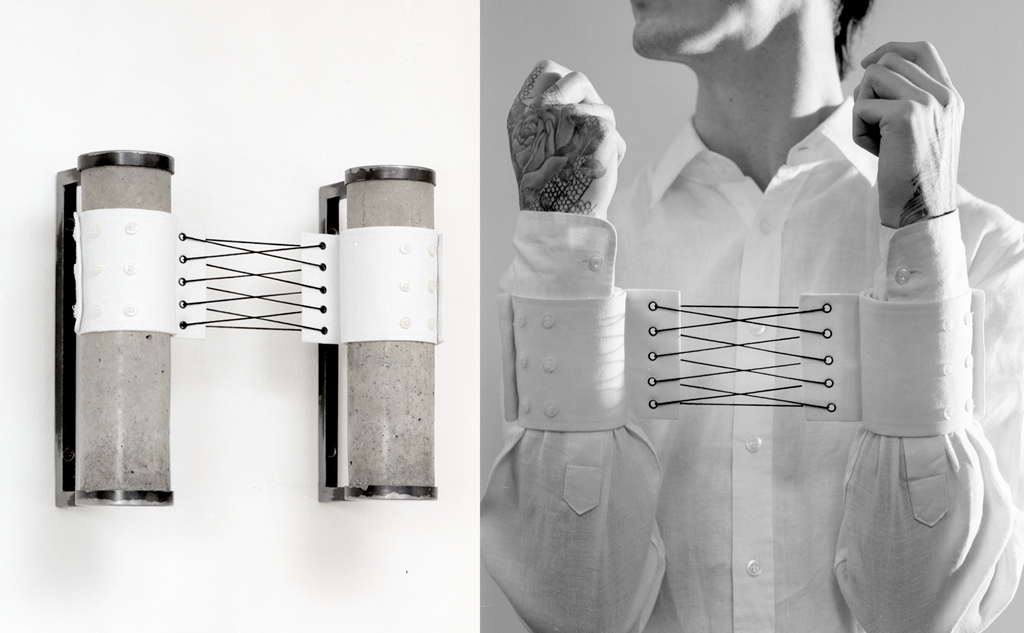SLASH: IN BETWEEN THE NORMATIVE AND THE FANTASY
Participants: Tom of Finland, Aleesa Cohene, Zackary Drucker and Rhys Ernst, Lucas Foletto Celinski, Atis Jākobsons, Vladislavs Nastavševs, Benny Nemerofsky Ramsay, Armīns Ozoliņš, Edgars Ozoliņš, Karol Radziszewski, Wolfgang Tillmans, Vilnis Vējš.
Curated by Kaspars Vanags
Curator of display of Tom of Finland art works and ephemera: Gary Everett
The opening of the exhibition: June 18, 7pm – 9pm.
Venue: kim? Contemporary Art Centre
Maskavas Street 12/1, Spikeri
Opening hours:
Tue: 12pm – 8pm
Wed, Thu, Fri, Sat, Sun.: 12pm – 6pm
Minors must be accompanied by a parent or legal guardian while visiting the exhibition.
June 19 – August 2, 2015
The exhibition Slash: In Between the Normative and the Fantasy is the first time a public art institution in Latvia is turning towards “slashes” among contemporary art expression. More than 20 years had to pass since the decriminalization of homosexuality for such an exhibition, influenced by the digitalisation of personal life, to be possible – borrowing from the open-source mentality. The other, here, isn’t juxtaposed to the norm as something locked in the solitude of an individual strangeness or an impossible taboo, but as an awareness of an essentially recognizable, reachable, and modifiable aspect of personal identity.
Stuck between the norm and fantasy, the slash questions the self-explanatory about sexual orientation. It questions the difference between identity and belonging, between belonging and decency. It does not concern only homosexuality, but a whole range of issues, which sometimes dart and zigzag through our minds. For the bent, the queer, first and foremost has to do with the right to be asexual and is unlikely to lead to pining for polyandry. The starting point here is to be found outside the context of partnership: it is the reflection of the queer on the self and an inner dialogue with the imagined possibilities aroused by the surrounding environment. Imagination is universal, therefore seductive art is meant even for the conservative. Straightness may lift one straight to heaven, but if we consider the infinite outside the Euclidian geometric framework, then the relationship between two parallel lines turns out to be less than straightforward, a little slanted, allowing for them to meet at some point.
The group exhibition consists of works that hold a friction between imagination and reality, with unexpected flickers of synergy in the place of routine sparks. The different fusion samples are of a variety of structures. There are fragments of personal stories, micro-history notes without any pretence to the status of an artwork, as well as art installations of a conceptual nature without narrative features. There are poetic subversions of the hetero-normative dominant in mass media, presented in a video format, and nearby – charcoal drawings, where the plaster casts of Roman busts, ubiquitous in the academic art education system, have seemingly lost their cast in stone identities. The stories of intimate human relations and changes brought by the changing of time are addressed by various photo series, and daily artefacts unexpectedly surfaced from the past proclaim a certain message.
Knitting together the period before the decriminalization of homosexuality in Latvia with the queer interpretations of the turn of the 21st century in contemporary art is an exercise in the tightrope walking of communication. Thus an almost atrophied form of communication, which is nevertheless crucial in any attempt to revisit the past, the letter, pops up here and there among the works included in the exhibition. Letters are placed in glass cases as documentary evidence of history, or serve as epistolary forms of social sculpture. At a time when you can officially stick a stamp with a Tom of Finland’s homoerotic drawing on an envelope, you might think that shortly before becoming extinct even the most conservative type of communication has succeeded in integrating the outsiders. How such a letter might reach its addressee in Latvia is one of the footnote questions of the Slash exhibition.
The exhibition includes work from the archives of Tom of Finland and Edgars Ozoliņš, and by the following participants: Zackary Drucker and Rhys Ernst (USA), Lucas Foletto-Celinski (Brazil, Germany), Atis Jākobsons (Latvia), Aleesa Cohene (Canada), Vladislas Nastavševs (Latvia), Benny Nemerofsky Ramsay (Canada, Germany), Armīns Ozoliņš (Latvia), Karol Radziszewski (Poland), Wolfgang Tillmans (Germany), Vilnis Vējš (Latvia).

Image: Lucas Foletto Celinski
Curators:
Kaspars Vanags is an art and culture theoretician. In the 90ties worked as a curator, together with like-minded thinkers in the fellowship Open organizing inter-disciplinary events, where he mixed visual art with trending rave music. Created projects in which art has a critical role of a social platform, turning against or creating an alternative to consumerism culture (Slideplays (2000); Subversion in the city (2001)). Later turned to studies of art history, obtained a degree in art history at the Courtauld Institute of Art. Lives in Berlin, where has worked as a maker of exhibitions and art critic. Curator of the Latvian exhibition in the 56th International Venice Biennale.
Gary Everett is the founder and current artistic director of Homotopia Liverpool. He produces an annual festival in the UK and works extensively internationally with projects in Finland, Sweden and Turkey. Recently he curated April Ashley, Portrait of a lady at Museum of Liverpool & extended twice due to popularity attracting record audiences of 930,000. Curated the year-long Tom of Finland Retrospective as part of Turku’s European Capital of Culture 2011 which attracted 90,000, which then toured to Kulturhuset Stockholm in 2012. Currently curating a major new project on the life of Touko Laaksonen (Tom of Finland) which opens in Turku in 2017. In December 2014 he was judged 53rd in the 100 most influential LGBT people in Britain in the Independent on Sunday’s annual Pink List.
